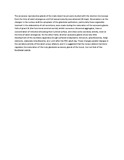| dc.description.abstract | The accessory reproductive glands of the male desert locust were studied with the electron microscope from the time of adult emergence until full sexual maturity was attained (10 days). Observations on the changes in the nucleus and the cytoplasm of the glandular epithelium, particularly those organelles involved in the elaboration of cell secretions, were made during the maturation of the accessory glands. Cells of gland 16 (the functional seminal vesicle) exhibit numerous ribosomal aggregates, have a concentration of mitochondria along their luminal surface, and show some secretory activity, even at the time of adult emergence. On the other hand, all other accessory glands show very little development of the secretory apparatus (rough-surfaced endoplasmic reticulum, polyribosomes, Golgi elements, elaborate mitochondria, etc.) until after the fifth adult day. These changes parallel changes in the secretory activity of the adult corpus allatum; and it is suggested that the corpus allatum hormone regulates the maturation of the truly glandular accessory glands of the locust, but not that of the functional vesicle. | en_US |

